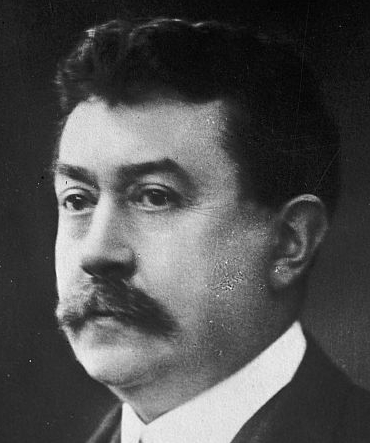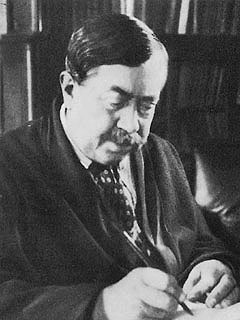<Back to Index>
- Mathematician and Prime Minister of France Paul Painlevé, 1863
- Poet Fyodor Ivanovich Tyutchev, 1803
- 8th President of the United States Martin Van Buren, 1782
PAGE SPONSOR


Paul Painlevé (5 December 1863 – 29 October 1933) was a French mathematician and politician. He served twice as Prime Minister of the Third Republic: 12 September – 13 November 1917 and 17 April – 22 November 1925.
Painlevé was born in Paris. Brought up within a family of skilled artisans (his father was a draughtsman) Painlevé showed early promise across the range of elementary studies and was initially attracted by either an engineering or political career. However, he finally entered the École Normale Supérieure in 1883 to study mathematics, receiving his doctorate in 1887 following a period of study at Göttingen, Germany, with Felix Klein and Hermann Amandus Schwarz. Intending an academic career he became professor at Université de Lille, returning to Paris in 1892 to teach at the Sorbonne, École Polytechnique and later at the Collège de France and the École Normale Supérieure. He was elected a member of the Académie des Sciences in 1900.
He married Marguerite Petit de Villeneuve in 1901. Marguerite died during the birth of their son Jean Painlevé in the following year.
Painlevé's
mathematical work on differential
equations led
him to encounter their application to the theory of flight and, as
ever, his broad interest in engineering topics fostered an enthusiasm
for the emerging field of aviation.
In 1908, he became Wilbur Wright's
first airplane passenger in France and in 1909 created the first
university course in aeronautics. Some differential
equations can be
solved using elementary algebraic operations that involve the trigonometric and exponential
functions (sometimes called elementary
functions). Many interesting special
functions arise
as solutions of linear second order ordinary differential equations.
Around the turn of the century, Painlevé, É. Picard,
and B. Gambier showed that of the class of nonlinear second order ordinary
differential equations with polynomial coefficients,
those
that possess a certain desirable technical property, shared by
the linear equations (nowadays commonly referred to as the 'Painlevé
property')
can always be transformed into one of fifty canonical forms. Of these
fifty equations, just six require 'new' transcendental functions for
their solution. These new transcendental
functions, solving the remaining six equations, are called the Painlevé
transcendents, and interest in them has revived recently due to
their appearance in modern geometry and statistical
mechanics. In the
nineteen twenties, Painlevé briefly turned his attention to the
new theory of gravitation, general
relativity, which had recently been introduced by Albert Einstein.
In 1921, Painlevé proposed the Gullstrand -
Painlevé coordinates for
the Schwarzschild
metric. The modification in the coordinate system was the first
to reveal clearly that the Schwarzschild
radius is a mere coordinate
singularity (with
however, profound global significance: it represents the event horizon of a black hole).
This essential point was not generally appreciated by physicists until
around 1963. In his diary, Harry Graf
Kessler recorded
that during a later visit to Berlin, Painlevé discussed pacifist international
politics with
Einstein, but there is no reference to discussions concerning the
significance of the Schwarzschild radius. Painlevé
took
his aviation interests, along with those in naval and military
matters, with him when he became, in 1906, Deputy for Paris's 5th
arrondissement, the so-called Latin Quarter.
By 1910, he had vacated his academic posts and World War I led to his
active participation in military committees, joining Aristide Briand's
cabinet in 1915 as Minister for Public Instruction and Inventions.
On
his appointment as War Minister in March 1917 he was immediately called
upon to give his approval, albeit with some misgivings, to Robert Georges
Nivelle's wildly optimistic plans for a breakthrough offensive in Champagne.
Painlevé reacted to the disastrous public failure of the plan by
dismissing Nivelle and controversially
replacing him with Henri Philippe
Pétain. On 7
September 1917, Prime Minister Alexandre Ribot lost the support of the Socialists and Painlevé was
called upon to form a new government.
Painlevé was a leading voice at the Rapallo
conference that
led to establishment of the Supreme Allied
Council, a consultative body of allied powers that anticipated the
unified Allied command finally established in the following year. He
appointed Ferdinand Foch as
French representative knowing that he was the natural Allied commander.
On Painlevé's return to Paris he was defeated and resigned on 13
November 1917 to be succeeded by Georges
Clemenceau. Foch was finally made commander
in chief of all Allied armies on the Western and Italian fronts in May
1918. Painlevé
then
played little active role in politics until the election of
November 1919 when he emerged as a leftist critic of the right wing Bloc National.
By the time the next election approached in May 1924 his collaboration
with Édouard
Herriot, a fellow member of Briand's 1915 cabinet, had led to
the formation of the Cartel des
Gauches.
Winning the election, Herriot became Prime Minister in June, while
Painlevé became President of the Chamber of Deputies. Though
Painlevé ran for President of
France in 1924
he was defeated by Gaston Doumergue.
Herriot's administration publicly recognised the Soviet Union, accepted
the Dawes Plan and agreed to evacuate the
Ruhr. However, a financial crisis arose from the ensuing
devaluation of the franc and
in April 1925, Herriot fell and Painlevé became Prime Minister
for a second time on 17 April. Unfortunately, he was unable to offer
convincing remedies for the financial problems and was forced to resign
on 21 November. Following
Painlevé's resignation, Briand formed a new government with
Painlevé as Minister for War. Though Briand was defeated by Raymond
Poincaré in
1926, Painlevé continued in office. Poincaré stabilised
the franc with a return to the gold standard,
but ultimately acceded power to Briand. During his tenure as Minister
of War, Painlevé was instrumental in the creation of the Maginot Line.
This line of military fortifications along France's Eastern border was
largely designed by Painlevé, yet named for André
Maginot, owing to Maginot's championing of public support and
funding. Painlevé
remained in office as Minister for War until July 1929. Though he
was proposed for President of
France in
1932, Painlevé withdrew before the election. He became Minister
of Air later that year, making proposals for an international treaty to
ban the manufacture of bomber aircraft and to establish an
international air force to enforce global peace. On the fall of the
government in January 1933, his political career ended. He died
in Paris in October of the same year.
Painlevé is now buried at the Panthéon.